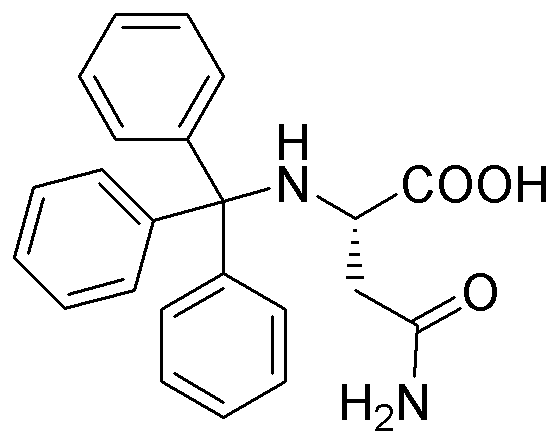Na-Trityl-L-asparagine is widely utilized in research focused on:
- Peptide Synthesis: This compound serves as a valuable building block in the synthesis of peptides, particularly in the development of pharmaceuticals where specific amino acid sequences are crucial.
- Protein Engineering: It is used in modifying proteins to enhance their stability and functionality, which is essential in biotechnological applications and therapeutic development.
- Drug Development: Researchers leverage its properties to create novel drug candidates, especially in targeting specific biological pathways, improving efficacy and reducing side effects.
- Biochemical Research: The compound aids in studying enzyme mechanisms and interactions, providing insights that can lead to breakthroughs in understanding metabolic pathways.
- Diagnostic Tools: Its application in the development of biosensors and diagnostic assays enhances the detection of biomolecules, which is vital in clinical diagnostics and monitoring health conditions.
General Information
Properties
Safety and Regulations
Applications
Na-Trityl-L-asparagine is widely utilized in research focused on:
- Peptide Synthesis: This compound serves as a valuable building block in the synthesis of peptides, particularly in the development of pharmaceuticals where specific amino acid sequences are crucial.
- Protein Engineering: It is used in modifying proteins to enhance their stability and functionality, which is essential in biotechnological applications and therapeutic development.
- Drug Development: Researchers leverage its properties to create novel drug candidates, especially in targeting specific biological pathways, improving efficacy and reducing side effects.
- Biochemical Research: The compound aids in studying enzyme mechanisms and interactions, providing insights that can lead to breakthroughs in understanding metabolic pathways.
- Diagnostic Tools: Its application in the development of biosensors and diagnostic assays enhances the detection of biomolecules, which is vital in clinical diagnostics and monitoring health conditions.
Documents
Safety Data Sheets (SDS)
The SDS provides comprehensive safety information on handling, storage, and disposal of the product.
Product Specification (PS)
The PS provides a comprehensive breakdown of the product’s properties, including chemical composition, physical state, purity, and storage requirements. It also details acceptable quality ranges and the product's intended applications.
Certificates of Analysis (COA)
Search for Certificates of Analysis (COA) by entering the products Lot Number. Lot and Batch Numbers can be found on a product’s label following the words ‘Lot’ or ‘Batch’.
*Catalog Number
*Lot Number
Certificates Of Origin (COO)
This COO confirms the country where the product was manufactured, and also details the materials and components used in it and whether it is derived from natural, synthetic, or other specific sources. This certificate may be required for customs, trade, and regulatory compliance.
*Catalog Number
*Lot Number
Safety Data Sheets (SDS)
The SDS provides comprehensive safety information on handling, storage, and disposal of the product.
DownloadProduct Specification (PS)
The PS provides a comprehensive breakdown of the product’s properties, including chemical composition, physical state, purity, and storage requirements. It also details acceptable quality ranges and the product's intended applications.
DownloadCertificates of Analysis (COA)
Search for Certificates of Analysis (COA) by entering the products Lot Number. Lot and Batch Numbers can be found on a product’s label following the words ‘Lot’ or ‘Batch’.
*Catalog Number
*Lot Number
Certificates Of Origin (COO)
This COO confirms the country where the product was manufactured, and also details the materials and components used in it and whether it is derived from natural, synthetic, or other specific sources. This certificate may be required for customs, trade, and regulatory compliance.


